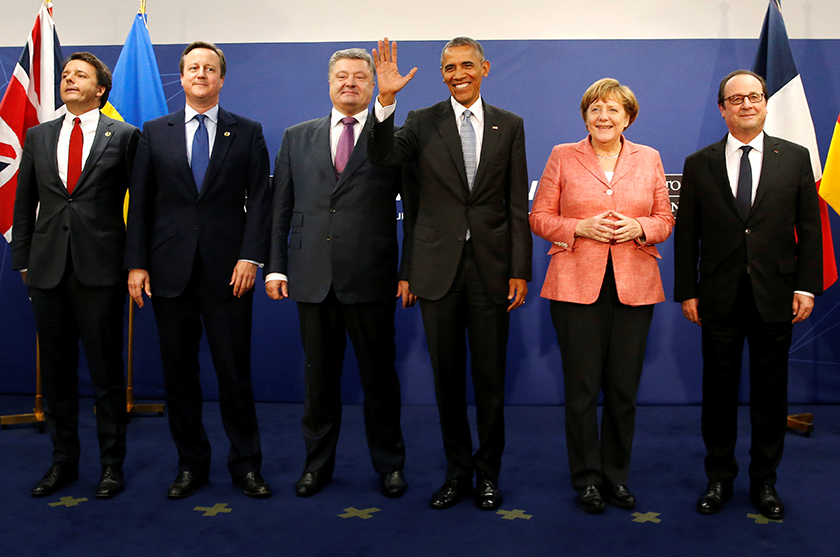 At the NATO Summit in Warsaw on July 8 and 9, the Alliance decided to deploy a multinational battalion in each of the following frontline states: Poland, Lithuania, Latvia, and Lithuania. These forces, totaling some 4,000 personnel, are expected to arrive sometime in 2017. Their mission: to deter Russian aggression.
At the NATO Summit in Warsaw on July 8 and 9, the Alliance decided to deploy a multinational battalion in each of the following frontline states: Poland, Lithuania, Latvia, and Lithuania. These forces, totaling some 4,000 personnel, are expected to arrive sometime in 2017. Their mission: to deter Russian aggression.
Six to nine months, if not more, is a long time to wait in the face of a significant and urgent threat. The Alliance should deploy elements of the 40,000-man NATO Response Force (NRF) to these countries until these elements can be backfilled by the later arrival of the committed US-, German-, Canadian- and UK-led battalions.
The Warsaw Summit Communiqué issued by NATO heads of state describes the threat posed by Moscow in unusually stark terms: “ Russia’s aggressive actions, including provocative military activities in the periphery of NATO territory and its demonstrated willingness to attain political goals by the threat and use of force, are a source of regional instability, fundamentally challenge the Alliance, have damaged Euro-Atlantic security, and threaten our long-standing goal of a Europe whole, free, and at peace.”
It goes on to say: “ Russia’s destabilising actions and policies include: the ongoing illegal and illegitimate annexation of Crimea, which we do not and will not recognise and which we call on Russia to reverse; the violation of sovereign borders by force; the deliberate destabilisation of eastern Ukraine; large-scale snap exercises contrary to the spirit of the Vienna Document, and provocative military activities near NATO borders, including in the Baltic and Black Sea regions and the Eastern Mediterranean; its irresponsible and aggressive nuclear rhetoric, military concept and underlying posture; and its repeated violations of NATO Allied airspace.”
The Alliance created the NRF for quick and decisive reaction against aggression. Launched in 2002, it is “a highly capable joint multinational force able to react in a very short time to the full range of security challenges from crisis management to collective defense.” The NRF features land, air, and sea elements.
The front edge of its ground force component is the Very High Readiness Joint Task Force (VJTF), featuring a multinational brigade of 5,000 troops. It is required to be ready to move with three days’ notice. The VJTF is backed up by an Initial Follow-On Forces Group (IFFG), consisting of two multinational brigades. (Generally speaking, brigades are made up of three or four battalions.)
At Warsaw, NATO leaders emphasized the readiness of the NRF and its VJTF spearhead force, highlighting recent decisions to increase their size, flexibility, deployability, and lethality.
So why not use the NRF temporarily to reinforce the Alliance’s eastern frontier?
It should not be an overly demanding task for the NRF. Four battalions would only constitute some 10 percent of the force’s overall manpower? Of its ground forces, the mission would take up only about a third, if not less, of its regular ground forces.
Using the NRF would not be unprecedented, but is long overdue. Its last operation (aside from exercises) dates back to 2005 when the NRF delivered humanitarian assistance to the United States and Caribbean neighbors in the aftermath of Hurricane Katrina and to earthquake victims in Pakistan. Elements of the force provided security to the 2004 summer Olympics in Athens, Greece.
Providing the initial force to reinforce NATO’s Central European frontier would not only demonstrate and test the NRF’s readiness for a collective defense, it would underscore the Alliance’s determination. And, as a combat ready force, NRF forces bring the survivability and lethality necessary to enhance the Alliance’s deterrent posture in that region.
NATO made the right decision to strengthen its eastern flank, even as it seeks to reduce tensions with Russia through engagement. But allowing a six to nine-month gap between that decision and its execution undercuts the presentation of Alliance unity, resolve, and capability against Moscow’s aggression. Indeed, the credibility of NATO’s diplomatic overtures will be shaped not only by the composition of it enhanced forward presence, but also by the dispatch with which it is deployed.
When former US Secretary of State Madeline K. Albright stood down hesitancy in the US government to use armed force to stop violence in the Balkans, she quipped: “’What’s the point of having this superb military that you’ve always been talking about if we can’t use it?”
Today, as NATO moves to reinforce its eastern frontier against Russian threats that “fundamentally challenge the Alliance,” this logic applies clearly to the NRF.
Ian Brzezinski is a resident senior fellow with the Atlantic Council’s Brent Scowcroft Center on International Security. He is also a member of the Council’s Strategic Advisors Group. Brzezinski served as US Deputy Assistant Secretary of Defense when the Alliance decided to establish the NATO Response Force in 2002.
Image: From left: Italian Prime Minister Matteo Renzi, British Prime Minister David Cameron, Ukrainian President Petro Poroshenko, US President Barack Obama, German Chancellor Angela Merkel, and French President François Hollande pose for a photograph after their meeting at the NATO Summit in Warsaw on July 9. (Reuters/Jonathan Ernst)

